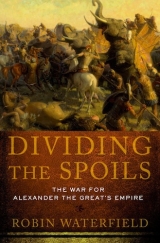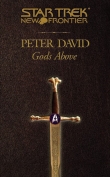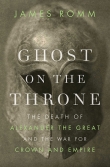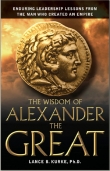
Текст книги "Dividing the Spoils: The War for Alexander the Great's Empire"
Автор книги: Robin Waterfield
Соавторы: Robin Waterfield,Robin Waterfield,Robin Waterfield
Жанр:
Военная история
сообщить о нарушении
Текущая страница: 21 (всего у книги 23 страниц)
(Paris: de Boccard).
*Briant, P., 2010,
Alexander the Great and His Empire: A Short Introduction
, trans. A. Kuhrt (Princeton: Princeton University Press).
*Bringmann, K., 1994, “The King as Benefactor: Some Remarks on Ideal Kingship in the Age of Hellenism,” in Bulloch et al. 1994, 7–24.
Brunt, P., 1975, “Alexander, Barsine and Heracles,”
Rivista di Filologia e d’Instruzione Classica
103, 22–34.
Bugh, G. (ed.), 2006a,
The Cambridge Companion to the Hellenistic World
(Cambridge: Cambridge University Press).
Bugh, G., 2006b, “Hellenistic Military Developments,” in Bugh 2006a, 265–94.
Bulloch, A., et al. (eds.), 1994,
Images and Ideologies: Self-Definition in the Hellenistic World
(Berkeley: University of California Press, 1994).
Burn, L., 2005,
Hellenistic Art from Alexander the Great to Augustus
(Los Angeles: Getty Publications).
Burstein, S., 1974,
Outpost of Hellenism: The Emergence of Heraclea on the Black Sea
(Berkeley: University of California Press).
Burstein, S., 1980, “Lysimachus and the Greek Cities of Asia: The Case of Miletus,”
Ancient World
3, 73–9.
Burstein, S., 1984, “Lysimachus the
Gazophylax
: A Modern Scholarly Myth?,” in W. Heckel and R. Sullivan (eds.),
Ancient Coins of the Graeco-Roman World
(Waterloo: Wilfred Laurier University Press), 57–68.
Burstein, S., 1986a, “Lysimachus and the Greek Cities: The Early Years,”
Ancient World
14, 19–24.
Burstein, S., 1986b, “Lysimachus and the Greek Cities: A Problem in Interpretation,”
Ancient Macedonia
4, 133–38.
Burstein, S., 2003/2008, “The Legacy of Alexander: New Ways of Being Greek in the Hellenistic Period,” in W. Heckel and L. Tritle (eds.),
Crossroads of History: The Age of Alexander
(Claremont: Regina), 217–42 (repr. as “Greek Identity in the Hellenistic Period,” in K. Zacharia (ed.),
Hellenisms: Culture, Identity, and Ethnicity from Antiquity to Modernity
(Aldershot: Ashgate), 59–77).
Canfora, L., 1990,
The Vanished Library: A Wonder of the Ancient World
(Berkeley: University of California Press).
Carlier, P., 2000, “Homeric and Macedonian Kingship,” in R. Brock and S. Hodkinson (eds.),
Alternatives to Athens: Varieties of Political Organization and Community in Ancient Greece
(Oxford: Oxford University Press), 259–68.
Carlsen, J., et al. (eds.), 1993,
Alexander the Great: Reality and Myth
(Rome: “L’Erma” di Bretschneider).
Carney, E., 1983, “Regicide in Macedonia,”
La Parola del Passato
38, 260–72.
Carney, E., 1994, “Olympias, Adea Eurydice, and the End of the Argead Dynasty,” in Worthington 1994a, 357–80.
Carney, E., 1995, “Women and
Basileia
: Legitimacy and Female Political Action in Macedonia,”
Classical Journal
90, 367–91.
Carney, E., 1999, “The Curious Death of the Antipatrid Dynasty,”
Ancient Macedonia
6, 209–16.
*Carney, E., 2000a,
Women and Monarchy in Macedonia
(Norman: University of Oklahoma Press).
Carney, E., 2000b, “The Initiation of Cult for Royal Macedonian Women,”
Classical Philology
95, 21–43.
Carney, E., 2001, “The Trouble with Philip Arrhidaeus,”
Ancient History Bulletin
15, 63–89.
Carney, E., 2004, “Women and Military Leadership in Macedonia,”
Ancient World
35, 184–95.
*Carney, E., 2006,
Olympias, Mother of Alexander the Great
(London: Routledge).
Carney, E., and Ogden, D. (eds.), 2010,
Philip II and Alexander the Great: Father and Son, Lives and Afterlives
(New York: Oxford University Press).
Cartledge, P., 2000, “Greek Political Thought: The Historical Context,” in C. Rowe and M. Schofield (eds.),
The Cambridge History of Greek and Roman Political Thought
(Cambridge: Cambridge University Press), 11–22.
Cartledge, P., 2004,
Alexander the Great: The Hunt for a New Past
(London: Macmillan).
Cartledge, P., et al. (eds.), 1997,
Hellenistic Constructs: Essays in Culture, History, and Historiography
(Berkeley: University of California Press).
Cawkwell, G., 1994, “The Deification of Alexander the Great: A Note,” in Worthington 1994a, 293–306.
*Chamoux, F., 2003,
Hellenistic Civilization
, trans. M. Roussel (Oxford: Blackwell).
Champion, J., 2009,
Pyrrhus of Epirus
(Barnsley: Pen & Sword).
Chaniotis, A., 2003, “The Divinity of Hellenistic Rulers,” in Erskine 2003, 431–45.
*Chaniotis, A., 2005,
War in the Hellenistic World
(Oxford: Blackwell).
Clarysse, W., 1985, “Greeks and Egyptians in the Ptolemaic Army and Administration,”
Aegyptus
65, 57–66.
Cohen, G., 1978,
The Seleucid Colonies: Studies in Founding, Administration and Organization
(Wiesbaden: Steiner = Historia Einzelschriften 30).
Cole, S.G., 1984,
Theoi Megaloi: The Cult of the Great Gods at Samothrace
(Leiden: Brill).
Collins, A., 2001, “The Office of Chiliarch under Alexander and the Successors,”
Phoenix
55, 259–83.
Collins, N., 1997, “The Various Fathers of Ptolemy I,”
Mnemosyne
ser. 4, 50, 436–76.
*Collins, N., 2000,
The Library in Alexandria and the Bible in Greek
(Leiden: Brill).
Connor, P. (ed.), 1994,
Ancient Macedonia: An Australian Symposium
(Sydney: Meditarch =
Mediterranean Archaeology
7, 1–126).
*Cribb, J., and Herrmann, G. (eds.), 2007,
After Alexander: Central Asia before Islam
(Oxford: Oxford University Press =
Proceedings of the British Academy
133).
Decleva Caizzi, F., 1994, “The Porch and the Garden: Early Hellenistic Images of the Philosophical Life,” in Bulloch et al. 1994, 303–29.
Delev, P., 2000, “Lysimachus, the Getae and Archaeology,”
Classical Quarterly
n.s. 50, 384–401.
Delev, P., 2003, “Lysimachus and the Third War of the Successors (314–311
BC
),” in H. Angelova (ed.),
Thracia Pontica VI.2
(Sofia: Center for Underwater Archaeology), 63–70.
Depuydt, L., 1997, “The Time of Death of Alexander the Great: 11 June 323
BC
(–322), ca. 4:00–5:00 pm,”
Die Welt des Orients
28, 117–35 (with an appendix in id.,
From Xerxes’ Murder (465) to Arridaios’ Execution (317): Updates to Achaemenid Chronology
(Oxford: Archaeopress, 2008), 47–51).
Devine, A. M., 1984, “Diodorus’ Account of the Battle of Gaza,”
Acta Classica
27, 31–40.
Devine, A. M., 1985a, “Diodorus’ Account of the Battle of Paraitacene (317 b.c.),”
Ancient World
12, 75–86.
Devine, A. M., 1985b, “Diodorus’ Account of the Battle of Gabiene,”
Ancient World
12, 87–96.
Dimitrov, D., and

i

ikova, M., 1978,
The Thracian City of Seuthopolis
, trans. M. P. Alexieva (Oxford: Archaeopress).
*Dixon, M., 2007, “Corinth, Greek Freedom, and the Diadochoi, 323–301
BC
,” in Heckel et al. 2007, 151–78.
Dmitriev, S., 2004, “Alexander’s Exiles Decree,”
Klio
86, 34–81.
Dmitriev, S., 2007, “The Last Marriage and the Death of Lysimachus,”
Greek, Roman, and Byzantine Studies
47, 135–49.
Dreyer, B., 2009, “Heroes, Cults, and Divinity,” in Heckel/Tritle 2009, 218–34.
Eckstein, A., 2009, “Hellenistic Monarchy in Theory and Practice,” in R. Balot (ed.),
A Companion to Greek and Roman Political Thought
(Oxford: Blackwell), 247–65.
*Eddy, S., 1961,
The King Is Dead: Studies in the Near Eastern Resistance to Hellenism 334–31
BC
(Lincoln: University of Nebraska Press).
Ehrenberg, V., 1969,
The Greek State
(2nd ed., London: Methuen).
Ellis, W., 1994,
Ptolemy of Egypt
(London: Routledge).
Engels, D., 1978a, “A Note on the Death of Alexander,”
Classical Philology
73, 224–28.
Engels, D., 1978b,
Alexander the Great and the Logistics of the Macedonian Army
(Berkeley: University of California Press).
Epplett, C., 2007, “War Elephants in the Hellenistic World,” in Heckel et al. 2007, 209–32.
Errington, R. M., 1970, “From Babylon to Triparadeisos: 323–320
BC
,”
Journal of Hellenic Studies
90, 49–77.
Errington, R. M., 1974, “Macedonian ‘Royal Style’ and Its Historical Significance,”
Journal of Hellenic Studies
94, 20–37.
Errington, R. M., 1976, “Alexander in the Hellenistic World,” in E. Badian (ed.),
Alexandre le Grand: Image et réalité
(Geneva: Fondation Hardt), 137–79.
Errington, R. M., 1977, “Diodorus Siculus and the Chronology of the Early Diadochi,”
Hermes
105, 478–504.
Errington, R. M., 1978, “The Nature of the Macedonian State under the Monarchy,”
Chiron
8, 77–133.
Errington, R. M., 1990,
A History of Macedonia
, trans. C. Errington (Berkeley: University of California Press).
*Errington, R. M., 2008,
A History of the Hellenistic World
(Oxford: Blackwell).
*Erskine, A., 1995, “Culture and Power in Ptolemaic Egypt: The Museum and Library of Alexandria,”
Greece and Rome
42, 38–48.
*Erskine, A., 2002, “Life after Death: Alexandria and the Body of Alexander,”
Greece and Rome
49, 163–79.
Erskine, A. (ed.), 2003,
A Companion to the Hellenistic World
(Oxford: Blackwell).
Ferguson, J., 1973,
The Heritage of Hellenism
(London: Thames and Hudson).
Ferguson, J., 1975,
Utopias in the Classical World
(London: Thames and Hudson).
Ferguson, W. S., 1948, “Demetrius Poliorcetes and the Hellenic League,”
Hesperia
17, 112–36.
Fraser, P., 1972,
Ptolemaic Alexandria
, 3 vols. (Oxford: Oxford University Press).
Fraser, P., 1996,
Cities of Alexander the Great
(Oxford: Oxford University Press).
Fredricksmeyer, E., 1979, “Divine Honors for Philip II,”
Transactions of the American Philological Association
109, 39–61.
Fredricksmeyer, E., 1981, “On the Background of the Ruler Cult,” in H. J. Dell (ed.),
Ancient Macedonian Studies in Honor of Charles F. Edson
(Thessaloniki: Institute for Balkan Studies), 145–56.
Fredricksmeyer, E., 2000, “Alexander the Great and the Kingdom of Asia,” in Bosworth/Baynham 2000, 136–66.
Frösén, J. (ed.), 1997,
Early Hellenistic Athens: Symptoms of a Change
(Helsinki: Finnish Institute at Athens).
Gabbert, J., 1997,
Antigonos II Gonatas: A Political Biography
(London: Routledge). Garlan, Y., 1984, “War and Siegecraft,” in Walbank et al. 1984, 353–62.
Goukowsky, P., 1978/1981,
Essai sur les origines du mythe d’Alexandre, 336–270 av. J.-C
., 2 vols. (Nancy: Université de Nancy).
Grainger, J., 1990a,
The Cities of Seleukid Syria
(Oxford: Oxford University Press).
*Grainger, J., 1990b,
Seleukos Nikator: Constructing a Hellenistic Kingdom
(London: Routledge).
*Grainger, J., 1992,
Hellenistic Phoenicia
(Oxford: Oxford University Press).
Grainger, J., 1999,
The League of the Aetolians
(Leiden: Brill).
Grainger, J., 2007,
Alexander the Great Failure: The Collapse of the Macedonian Empire
(New York: Continuum).
*Green, P., 1990,
Alexander to Actium: The Historical Evolution of the Hellenistic Age
(Berkeley: University of California Press).
Green, P., 1991,
Alexander of Macedon, 356–323
BC
: A Historical Biography
(Berkeley: University of California Press).
*Green, P. (ed.), 1993,
Hellenistic History and Culture
(Berkeley: University of California Press).
Green, P., 2003, “Delivering the Go(o)ds: Demetrius Poliorcetes and Hellenistic Divine Kingship,” in G. Bakewell and J. Sickinger (eds.),
Gestures: Essays in Ancient History, Literature and Philosophy Presented to Alan L. Boegehold
(Oxford: Oxbow, 2003), 258–77.
Green, P., 2007,
The Hellenistic Age: A Short History
(New York: The Modern Library).
Greenwalt, W., 1984, “The Search for Arrhidaeus,”
Ancient World
10, 69–77.
Greenwalt, W., 1988, “Argaeus, Ptolemy II and Alexander’s Corpse,”
Ancient History Bulletin
2, 39–41.
Greenwalt, W., 1989, “Polygamy and Succession in Argead Macedonia,”
Arethusa
22, 19–43.
Greenwalt, W., 1999, “Argead Name Changes,”
Ancient Macedonia
6, 453–62.
Greenwalt, W., 2010, “Argead
Dunasteia
during the Reigns of Philip II and Alexander III: Aristotle Reconsidered,” in Carney/Ogden 2010, 151–63 (and endnotes).
Griffith, G. T., 1935/1984,
The Mercenaries of the Hellenistic World
(Cambridge: Cambridge University Press; repr. Chicago: Ares Press).
Griffith, G. T. (ed.), 1966,
Alexander the Great: The Main Problems
(Cambridge: Heffer).
Gruen, E., 1985, “The Coronation of the Diadochoi,” in J. Eadie and J. Ober (eds.),
The Craft of the Ancient Historian: Essays in Honor of C. G. Starr
(Lanham: University Press of America), 253–71.
Gruen, E., 1993, “The Polis in the Hellenistic World,” in R. Rosen and J. Farrell (eds.),
Nomodeiktes: Studies in Honor of Martin Ostwald
(Ann Arbor: University of Michigan Press), 339–54.
*Gutzwiller, K., 2007,
A Guide to Hellenistic Literature
(Oxford: Blackwell). Habicht, C., 1970,
Gottmenschentum und griechische Städte
(2nd ed., Munich: Beck).
*Habicht, C., 1997,
Athens from Alexander to Antony
, trans. D. Schneider (Cambridge: Harvard University Press).
Hadley, R. A., 1974, “Royal Propaganda of Seleucus I and Lysimachus,”
Journal of Hellenic Studies
94, 50–65.
Hadot, P., 2002, “The Hellenistic Schools,” ch. 7 (pp. 91–145) of
What Is Ancient Philosophy?
, trans. M. Chase (Cambridge: Harvard University Press).
Hahm, D., 2000, “Kings and Constitutions: Hellenistic Theories,” in C. Rowe and M. Schofield (eds.),
The Cambridge History of Greek and Roman Political Thought
(Cambridge: Cambridge University Press), 457–76.
Hamilton, J. R., 1984, “The Origins of Ruler-Cult,”
Prudentia
16, 3–16.
Hammond, N. G. L., 1984, “Alexander’s Veterans after His Death,”
Greek, Roman, and Byzantine Studies
25, 51–61.
Hammond, N. G. L., 1985, “Some Macedonian Offices
c
. 336–309
BC
,”
Journal of Hellenic Studies
105, 156–60.
Hammond, N. G. L., 1988, “The Royal Journal of Alexander,”
Historia
37, 129–50.
Hammond, N. G. L., 1989a,
The Macedonian State: The Origins, Institutions, and History
(Oxford: Oxford University Press).
Hammond, N. G. L., 1989b,
Alexander the Great: King, Commander and Statesman
(2nd ed., Bristol: Bristol Classical Press).
Hammond, N. G. L., 1989c, “Arms and the King: The Insignia of Alexander the Great,”
Phoenix
43, 217–24.
Hammond, N. G. L., 1993, “The Macedonian Imprint on the Hellenistic World,” in Green 1993, 12–23 (with a response by E. Borza, 23–35).
Hammond, N. G. L., 1999, “The Nature of the Hellenistic States,”
Ancient Macedonia
6, 483–88.
Hammond, N. G. L., 2000, “The Continuity of Macedonian Institutions and the Macedonian Kingdoms of the Hellenistic Era,”
Historia
49, 141–60.
*Hammond, N. G. L., Griffith, G. T., and Walbank, F. W., 1972/1979/1988,
A History of Macedonia
, 3 vols. (Oxford: Oxford University Press). The third volume, by Hammond and Walbank, is of most relevance to this book.
Hatzopoulos, M., 1996,
Macedonian Institutions under the Kings: A Historical and Epigraphical Study
, 2 vols. (Athens: Center for Greek and Roman Antiquity).
Hauben, H., 1974, “A Royal Toast in 302
BC
,”
Ancient Society
5, 105–17.
Hauben, H., 1977a, “The First War of the Successors (321
BC
): Chronological and Historical Problems,”
Ancient Society
8, 85–120.
Hauben, H., 1977b, “Rhodes, Alexander and the Diadochi from 333/2–304
BC
,”
Historia
26, 307–39.
Heckel, W., 1982, “The Career of Antigenes,”
Symbolae Osloenses
57, 57–67.
Heckel, W., 1985, “The Macedonian Veterans in Kilikia,”
Liverpool Classical Monthly
10, 109–10.
Heckel, W., 1988,
The Last Days and Testament of Alexander the Great: A Prosopographic Study
(Stuttgart: Steiner =
Historia
Einzelschriften 56).
*Heckel, W., 1992,
The Marshals of Alexander’s Empire
(London: Routledge, 1992). [Much of the material of this book is repeated in id.,
Who’s Who in the Age of Alexander: Prosopography of Alexander’s Empire
(Oxford: Blackwell, 2006).]
Heckel, W., 1999, “The Politics of Antipatros, 324–319
BC
,”
Ancient Macedonia
6, 489–98.
Heckel, W., 2002, “The Politics of Distrust: Alexander and His Successors,” in D. Ogden (ed.),
The Hellenistic World: New Perspectives
(London: Duckworth), 81–95.
Heckel, W., 2007, “The Earliest Evidence for the Plot to Poison Alexander,” in Heckel et al. 2007, 265–75.
*Heckel, W., and Tritle, L. (eds.), 2009,
Alexander the Great: A New History
(Oxford: Wiley-Blackwell).
Heckel, W., et al. (eds.), 2007,
Alexander’s Empire: Formulation to Decay
(Claremont: Regina).
Herman, G., 1980–81, “The ‘Friends’ of the Early Hellenistic Rulers: Servants or Officials?”
Talanta
12–13, 103–49.
Herman, G., 1997, “The Court Society of the Hellenistic Age,” in Cartledge et al. 1997, 199–224.
Hölbl, G., 2000,
A History of the Ptolemaic Empire
, trans. T. Saavedra (London: Routledge).
Holt, F., 1988,
Alexander the Great and Bactria: The Formation of a Greek Frontier in Central Asia
(Leiden: Brill).
Holt, F., 1999,
Thundering Zeus: The Making of Hellenistic Bactria
(Berkeley: University of California Press).
Hope Simpson, R., 1954, “The Political Circumstances of the Peace of 311
BC
,”
Journal of Hellenic Studies
74, 25–31.
Hope Simpson, R., 1955, “Ptolemaeus’ Invasion of Greece in 313
BC
,”
Mnemosyne
ser. 4, 8, 34–7.
Hope Simpson, R., 1957, “Antigonus, Polyperchon and the Macedonian Regency,”
Historia
6, 371–73.
Hope Simpson, R., 1959, “Antigonus the One-Eyed and the Greeks,”
Historia
8, 385–409.
Howe, S., 2002,
Empire: A Very Short Introduction
(Oxford: Oxford University Press).
*Hughes Fowler, B., 1989,
The Hellenistic Aesthetic
(Madison: University of Wisconsin Press).
Hunter, R., 2003, “Literature and Its Contexts,” in Erskine 2003, 477–93.
Invernizzi, A., 1996, “Seleucia on the Tigris: Centre and Periphery in Seleucid Asia,” in P. Bilde et al. (eds.),
Centre and Periphery in the Hellenistic World
(2nd ed., Aarhus: Aarhus University Press), 230–50.
Jenkins, G., 1967, “The Monetary Systems in the Early Hellenistic Time with Special Regard to the Economic Policy of the Ptolemaic Kings,” in A. Kindler (ed.),
Proceedings of the International Numismatic Convention, Jerusalem 1963
(Tel Aviv: Schocken), 53–74.
Johnson, C., 2000, “Ptolemy I’s Epiklesis
Soter
: Origin and Definition,”
Ancient History Bulletin
14, 101–6.
Johnson, C., 2002, “
OGIS
98 and the Divinization of the Ptolemies,”
Historia
5, 112–16.
Jones, A. H. M., 1940,
The Greek City from Alexander to Justinian
(Oxford: Oxford University Press).
Jordan, D., 1980, “Two Inscribed Lead Tablets from a Well in the Athenian Kerameikos,”
Mitteilungen des Deutschen Archäologischen Instituts: Athenische Abteilung
95, 225–39.
Kertész, I., 1974, “Ptolemy I and the Battle of Gaza,”
Studia Aegyptica
, 231–41.
Koenen, L., 1994, “The Ptolemaic King as a Religious Figure,” in Bulloch et al. 1994, 25–115.
Kuhrt, A., 1996, “The Seleucid Kings and Babylonia: New Perspectives,” in P. Bilde et al. (eds.),
Aspects of Hellenistic Kingship
(Aarhus: Aarhus University Press), 41–54.
Kuhrt, A., and Sherwin-White, S., 1994, “The Transition from Achaemenid to Seleucid Rule in Babylonia: Revolution or Evolution?,”
Achaemenid History
8, 311–27.
*Kuhrt, A., and Sherwin-White, S. (eds.), 1988,
Hellenism in the East: The Interaction of Greek and Non-Greek Civilizations from Syria to Central Asia after Alexander
(Berkeley: University of California Press).
Landucci Gattinoni, F., 1992,
Lisimaco di Tracia: Un sovrano nella prospettiva del primo ellenismo
(Milan: Jaca, 1992).
Landucci Gattinoni, F., 2003,
L’arte del potere: Vita e opere di Cassandro di Macedonia
(Stuttgart: Steiner =
Historia
Einzelschriften 171).
Landucci Gattinoni, F., 2009, “Cassander’s Wife and Heirs,” in Wheatley/Hannah 2009, 261–75.
Landucci Gattinoni, F., 2010, “Cassander and the Legacy of Philip II and Alexander III in Diodorus’
Library
,” in Carney/Ogden 2010, 113–21 (and endnotes).
*Lane Fox, R., 1973,
Alexander the Great
(London: Allen Lane).
Lattimore, S., 1997, “Art and Architecture,” in L. Tritle (ed.),
The Greek World in the Fourth Century
(London: Routledge, 1997), 249–82.
Launey, M., 1949/1950,
Recherches sur les armées hellénistiques
, 2 vols. (Paris: Bibliothèque des écoles françaises d’Athènes et de Rome).
Lianou, M., 2010, “The Role of the Argeadai in the Legitimation of the Ptolemaic Dynasty,” in Carney/Ogden 2010, 123–33 (and endnotes).
Lightfoot, J., 2000, “Sophisticates and Solecisms: Greek Literature after the Classical Period,” in O. Taplin (ed.),
Literature in the Greek World
(Oxford: Oxford University Press), 199–238.
Ling, R., 1984,
The Cambridge Ancient History: Plates to Volume VII Part 1
(Cambridge: Cambridge University Press).
*Lloyd, G. E. R., 1973,
Greek Science after Aristotle
(New York: Norton).
Lock, R., 1977, “The Macedonian Army Assembly in the Time of Alexander the Great,”
Classical Philology
72, 91–107.
*Lund, H., 1992,
Lysimachus: A Study in Early Hellenistic Kingship
(London: Routledge).
Ma, J., 2000, “Fighting Poleis of the Hellenistic World,” in H. van Wees (ed.),
War and Violence in Ancient Greece
(London/Swansea: Duckworth/The Classical Press of Wales), 337–76.
Ma, J., 2003, “Kings,” in Erskine 2003, 177–95.
Macurdy, G., 1929, “The Political Activities and the Name of Cratesipolis,”
American Journal of Philology
50, 273–78.
Macurdy, G., 1932a/1985,
Hellenistic Queens: A Study of Woman-Power in Macedonia, Seleucid Syria, and Ptolemaic Egypt
(Baltimore: Johns Hopkins University Press; repr. Chicago: Ares).
Macurdy, G., 1932b, “Roxane and Alexander IV in Epirus,”
Journal of Hellenic Studies
52, 256–61.
Manning, J., 2003,
Land and Power in Ptolemaic Egypt: The Structure of Land Tenure
(Cambridge: Cambridge University Press).
*Manning, J., 2007, “Hellenistic Egypt,” in W. Scheidel et al. (eds.),
The Cambridge Economic History of the Greco-Roman World
(Cambridge: Cambridge University Press), 434–59.
*Manning, J., 2010,
The Last Pharaohs: Egypt under the Ptolemies, 305–30
BC
(Princeton: Princeton University Press).
Marr, J., and Calisher, C., 2003, “Alexander the Great and West Nile Virus Encephalitis,”
Emerging Infectious Diseases
12, 1599–1603.
Marsden, E., 1969,
Greek and Roman Artillery: Historical Development
(Oxford: Oxford University Press).
Martin, L., 1987,
Hellenistic Religions: An Introduction
(New York: Oxford University Press).
Martin, T., 1996, “Adeimantos of Lampsakos and Demetrios Poliorketes’ Fraudulent Peace of 302
BC
,” in R. Wallace and E. Harris (eds.),
Transitions to Empire: Essays in Greco-Roman History, 360–146, in Honor of E. Badian
(Norman: University of Oklahoma Press), 179–90.
McKechnie, P., 1999, “Manipulation of Themes in Quintus Curtius Rufus Book 10,”
Historia
48, 44–60.
McKenzie, L., 1994, “Patterns in Seleucid Administration: Macedonian or Near Eastern?,” in Connor 1994, 61–68.
McNicoll, A., and Milner, N., 1997,
Hellenistic Fortifications from the Aegean to the Euphrates
(Oxford: Oxford University Press).
*Meeus, A., 2008, “The Power Struggle of the Diadochoi in Babylonia, 323
BC
,”
Ancient Society
38, 39–82.
Meeus, A., 2009a, “Some Institutional Problems concerning the Succession to Alexander the Great:
Prostasia
and Chiliarchy,”
Historia
58, 287–310.
Meeus, A., 2009b, “Kleopatra and the Diadochoi,” in P. van Nuffelen (ed.),
Faces of Hellenism: Studies in the History of the Eastern Mediterranean (4th Century
BC
–5th Century AD)
(Leuven: Peeters), 63–92.
Meeus, A., 2009c, “Alexander’s Image in the Age of the Successors,” in Heckel/Tritle 2009, 235–50.
Mendels, D., 1984/1998, “Aetolia 331–301: Frustration, Political Power, and Survival,”
Historia
33, 129–80 (repr. in id.,
Identity, Religion and Historiography: Studies in Hellenistic History
(Sheffield: Sheffield Academic Press), 36–100).
Merker, I., 1979, “Lysimachus—Thessalian or Macedonian?”
Chiron
9, 31–6.
*Migeotte, L., 2009,
The Economy of the Greek Cities from the Archaic Period to the Early Roman Empire
, trans. J. Lloyd (Berkeley: University of California Press).
Mikalson, J., 1998,
Religion in Hellenistic Athens
(Berkeley: University of California Press, 1998).
*Mikalson, J., 2006, “Greek Religion: Continuity and Change in the Hellenistic Period,” in Bugh 2006a, 208–22.
Miller, S., 1986, “Alexander’s Funeral Cart,”
Ancient Macedonia
4, 401–11.
Miller, S., 1993,
The Tomb of Lyson and Kallikles: A Painted Macedonian Tomb
(Mainz am Rhein: von Zabern).
Mitchell, L., 2007, “Born to Rule? Succession in the Argead Royal House,” in Heckel et al. 2007, 61–74.
Mookerji, R. K., 1966/1999,
Chandragupta Maurya and His Times
, 4th ed. (New Delhi: South Asia Books; repr. Delhi: Banarsidass).
Mooren, L., 1983, “The Nature of the Hellenistic Monarchy,” in E. Van’t Dack et al. (eds.),
Egypt and the Hellenistic World
(Leuven: Peeters), 205–40.
Mooren, L., 1998, “Kings and Courtiers: Political Decision-Making in the Hellenistic States,” in W. Schuller (ed.),
Politische Theorie und Praxis im Altertum
(Darmstadt: Wissenschaftliche Buchgesellschaft), 122–33.
Morris, I., and Scheidel, W., 2009,
The Dynamics of Ancient Empires: State Power from Assyria to Byzantium
(Oxford: Oxford University Press).
Morrison, J. S., 1987, “Athenian Sea-Power in 323/2
BC
: Dream and Reality,”
Journal of Hellenic Studies
107, 88–97.
Mueller, K., 2006,
Settlements of the Ptolemies: City Foundation and New Settlement in the Hellenistic World
(Leuven: Peeters).
Murray, W., 2012,
The Age of Titans: Big Ships and the Exercise of Naval Power during the Hellenistic Age
(New York: Oxford University Press).
Musti, D., 1984, “Syria and the East,” in Walbank et al. 1984, 175–220.
Mylonas, G., 1961,
Eleusis and the Eleusinian Mysteries
(London: Routledge & Kegan Paul). Nielsen, I., 1994,
Hellenistic Palaces: Tradition and Renewal
(Aarhus: Aarhus University Press).
*Ogden, D., 1999,
Polygamy, Prostitutes and Death: The Hellenistic Dynasties
(London: Duckworth).
*Oleson, J. (ed.), 2008,
The Oxford Handbook of Engineering and Technology in the Classical World
(Oxford: Oxford University Press).
*Oliver, G., 2007,
War, Food, and Politics in Early Hellenistic Athens
(Oxford: Oxford University Press).
O’Neil, J., 1999, “Political Trials under Alexander the Great and His Successors,”
Antichthon
33, 28–47.
O’Neil, J., 2000, “Royal Authority and City Law under Alexander and His Hellenistic Successors,”
Classical Quarterly
n.s. 50, 424–31.
O’Sullivan, L., 2008, “
Le Roi Soleil
: Demetrius Poliorcetes and the Dawn of the Sun King,”
Antichthon
42, 78–99.
*O’Sullivan, L., 2009,
The Regime of Demetrius of Phalerum in Athens, 317–307
BC
: A Philosopher in Politics
(Leiden: Brill).
Pagden, A., 2001,
Peoples and Empires: A Short History of European Migration, Exploration and Conquest from Greece to the Present
(London: Modern Library, 2001).
*Palagia, O., and Tracy, S. (eds.), 2003,
The Macedonians in Athens, 322–229
BC
(Oxford: Oxbow).
Paspalas, S., 2005, “Philip Arrhidaios at Court—An Ill-Advised Persianism? Macedonian Royal Display in the Wake of Alexander,”
Klio
87, 72–101.
*Pollitt, J. J., 1986,
Art in the Hellenistic Age
(Cambridge: Cambridge University Press).
Pomeroy, S., 1977, “
Technikai kai Mousikai
: The Education of Women in the Fourth Century and in the Hellenistic Period,”
American Journal of Ancient History
2, 51–68.
*Potter, D., 2003, “Hellenistic Religion,” in Erskine 2003, 407–30.
Potts, D., 1990,
The Arabian Gulf in Antiquity
, vol. 2:
From Alexander the Great to the Coming of Islam
(Oxford: Oxford University Press).
Von Reden, S., 2001, “The Politics of Monetization in Third-Century
BC
Egypt,” in A. Meadows and K. Shipton (eds.),
Money and Its Uses in the Ancient Greek World
(Oxford: Oxford University Press), 65–76.
Von Reden, S., 2007,
Money in Ptolemaic Egypt from the Macedonian Conquest to the End of the Third Century
BC
(Cambridge: Cambridge University Press).
Ridgway, B., 2001,
Hellenistic Sculpture
, vol. 1:
The Styles of ca. 331–200
BC
(Madison: University of Wisconsin Press).
Robert, L., 1966/2007, “Sur un décret d’Ilion et sur un papyrus concernant des cultes royaux,” in A. Samuel (ed.),
Essays in Honor of C. B. Welles
(New Haven: American Society of Papyrologists), 175–210 (repr. in id.,
Choix d’écrits
, ed. D. Rousset (Paris: Les Belles Lettres), 569–601).
Robertson, M., 1993, “What Is “‘Hellenistic’ about Hellenistic Art?,” in Green 1993, 67–90 (with a response by J. J. Pollitt, 90–103).
Rodgers, W., 1937,
Greek and Roman Naval Warfare: A Study of Strategy, Tactics, and Ship Design from Salamis (480
BC
) to Actium (31
BC
)
(Annapolis: Naval Institute Press).
Roisman, J. (ed.), 2003,
Brill’s Companion to Alexander the Great
(Leiden: Brill).
*Romm, J., 2011,
Ghost on the Throne: The War for the Corpse, Crown and Empire of Alexander the Great
(New York: Simon & Schuster).
Rostovtzeff, M., 1941,
The Social and Economic History of the Hellenistic World
, 3 vols. (London: Oxford University Press).
Rowlandson, J., 2003, “Town and Country in Ptolemaic Egypt,” in Erskine 2003, 249–63.
Roy, J., 1998, “The Masculinity of the Hellenistic King,” in L. Foxhall and J. Salmon (eds.),
When Men Were Men: Masculinity, Power and Identity in Classical Antiquity
(London: Routledge), 111–35.
Saatsoglou-Paliadeli, C., 2007, “La peinture de la chasse de Vergina,” in S. Deschamps-Lequime (ed.),
Peinture et couleur dans le monde grec antique
(Paris: Musée de Louvre), 47–55.
Sabin, P., 2007, “Land Battles,” in P. Sabin et al. (eds.),
The Cambridge History of Greek and Roman Warfare
(Cambridge: Cambridge University Press), 399–433.
Samuel, A., 1993, “The Ptolemies and the Ideology of Kingship,” in Green 1993, 168–92 (with a response by D. Delia, 192–204).
Sanders, L., 1991, “Dionysius I of Syracuse and the Origins of Ruler Cult in the Greek World,”
Historia
40, 275–87.
Scharfe, H., 1971, “The Maurya Dynasty and the Seleucids,”
Zeitschrift für vergleichende Sprachforschung
85, 211–25.
Schep, L., 2009, “The Death of Alexander the Great: Reconsidering Poison,” in Wheatley/Hannah 2009, 227–36.
Schlumberger, D., 1969, “Triparadisos,”
Bulletin du Musée de Beyrouth
22, 147–49.
Schober, L., 1981,
Untersuchungen zur Geschichte Babyloniens und der oberen Satrapien von 323–303 v. Chr
. (Frankfurt: Lang).
Scullard, H., 1974,
The Elephant in the Greek and Roman World
(Ithaca: Cornell University Press).
Seibert, J., 1983,
Das Zeitalter der Diadochen
(Darmstadt: Wissenschaftliche Buchgesellschaft).
Seyrig, H., 1988, “Seleucus I and the Foundation of Hellenistic Syria,” in W. A. Ward (ed.),
The Role of the Phoenicians in the Interaction of Mediterranean Civilizations
(Beirut: American University of Beirut), 53–63.
Sfameni Gasparro, G., 1997, “
Daimôn
and
Tuchê
in the Hellenistic Religious Experience,” in P. Bilde et al. (eds.),
Conventional Values of the Hellenistic Greeks
(Aarhus: Aarhus University Press), 67–109.
Sharples, I., 1994, “Curtius’ Treatment of Arrhidaeus,” in Connor 1994, 53–60.
Sharples, R., 2006, “Philosophy for Life,” in Bugh 2006a, 223–40.
Shear, T. L., 1978,
Kallias of Sphettos and the Revolt of Athens in 286
BC
(Princeton: American School of Classical Studies at Athens =








